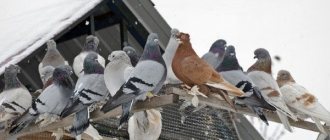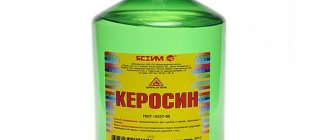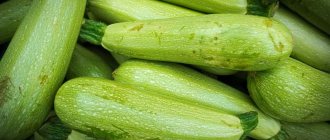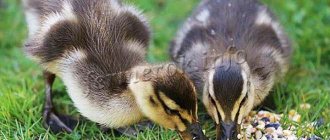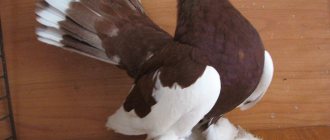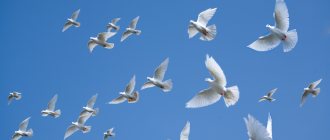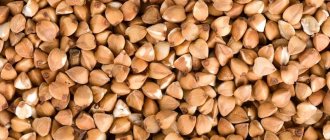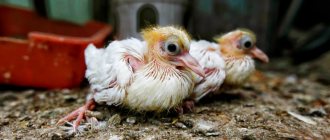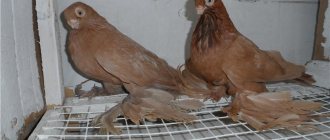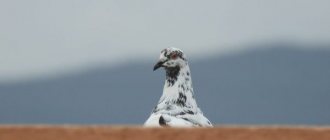In the cold season, street pigeons need adequate nutrition, but under a thick blanket of snow the chances of finding food are zero. Caring people build feeders for the city's feathered “friends” and bring a variety of food there.
Many products replenish the birds' necessary energy reserves and help them survive on frosty days; some can lead to various diseases and death. In order not to harm the blue-winged birds during feeding, you should familiarize yourself with the features of the winter diet for pigeons.
What do pigeons eat in the wild?
Street birds obtain their own food. As a rule, the components of their diet are:
- plants' seeds;
- cereals (rice, buckwheat, barley, millet);
- greenery;
- insects.
Pigeons often settle in large cities, where it is quite difficult for them to find food. During the autumn and summer periods, birds can still feed on grass, seeds and grains of various plants. However, in cities, flowers and grasses are often cut down, so birds do not receive enough of this food. In addition, they spend a lot of time mining it. Meanwhile, in winter things are even more complicated, since at this time of year many sources of food are completely hidden under a layer of snow.
What do pigeons eat when they don’t have access to seeds, greens and other natural food? In this case, they settle in places where people feed them. So, in their diet appear in large quantities:
- bakery products;
- sunflower seeds;
- food waste near trash cans.
However, this is the wrong diet for birds. Although pigeons eat seeds, bread crumbs and even waste with great appetite, they harm themselves because such food is poorly digested in their stomach, which is due to the peculiarities of the enzyme content and the rate of processing of food particles.
An unbalanced diet leads to a reduction in the average life expectancy of street pigeons by 3 times: their biological age is 13-15 years, but on the street they rarely live longer than 6 years, since they die from pathologies of the gastrointestinal tract.
Feeding outdoor pigeons
Animals living outdoors most often feed on shoots and grasses. In the absence of additional feeding, the birds will find food on their own. These will be seeds, grains of various cereals, grass leaves.
For purebred pigeons, such feeding will be quite balanced from spring to autumn.
However, often in cities, workers of housing and communal services and public improvement agencies mow the grass and trim the leaves of trees, removing opportunities for adult birds to feed.
Therefore, the feathered inhabitants of cities can starve, eating crumbs of bread or rolls, cereals and other products from human hands.
What to give to street pigeons?
Many city residents like to feed pigeons. In addition, they willingly eat almost everything they receive from humans. In order not to harm these birds, you need to at least approximately understand the basic principles of their nutrition. So, the following should be taken into account:
- Pigeons have a fairly small stomach volume, so they need to be fed often, but in small portions;
- so that the birds are able to quickly digest the food they eat, they should not be overfed or force-fed;
- birds should be given food that they can independently grind with their beaks, since they can choke if they swallow solid food;
- If possible, birds should be given a variety of vitamin and mineral complexes that will help balance their “outdoor” diet.
Given these rules, it becomes clear that pigeons should not be given scraps from the human table. They should be fed with the following food:
- cereals, such as barley;
- cereals;
- beans;
- yeast;
- unroasted seeds.
Ideally, pigeons should be given special food from a pet store that contains all the microelements necessary for birds.
Rice
To feed pigeons, grain mixtures are used, which include various cereals, such as millet, buckwheat, pearl barley (rice is also possible). Specialized food will provide the body with the necessary substances. If you cannot regularly buy such mixtures, you can prepare them yourself.
Rice is low in fat and high in starch. Thanks to these characteristics, this cereal can be given to birds. Pigeons can be fed raw and cooked rice. To feed them, peeled or unrefined (in moderation) grains are used. They are often mixed with other grains to increase the nutritional value of the feed.
It is acceptable to feed pigeons different types of rice. They happily eat white round, long steamed, brown.
Before mixing with other cereals, it is recommended to chop the rice a little, then the cereal will be better absorbed. Pigeons can be fed rice if they have digestive tract disorders. Before use, the grains are boiled until half cooked. The finished dish is sprinkled with chalk and given to the birds. Otherwise, they eat the rice raw.
Attention! It is forbidden to feed pigeons boiled rice in large quantities and often. Otherwise, the risk of pathologies of the nervous system increases.
Feeding poultry
The diet of domestic pigeons is often varied, as it consists of various crops:
In order for the diet to be balanced, it is necessary to correctly create a menu. The main food is a grain mixture, which can be bought at any pet store or prepared with your own hands. Here is the optimal composition of the mixture:
- oats – 50%;
- barley – 30%;
- pearl barley – 10%;
- millet – 10%.
Millet is a grain that must be fed to pigeons with great care as it can be toxic to them.
When feeding pigeons, you should also consider the following recommendations:
- Wheat should be fed in small quantities, as it can lead to obesity in the bird. Its optimal share in the daily diet is about 30%. The rest comes from other grains and legumes.
- You should include succulent food like grass in your bird's daily diet. You can collect it from nearby lawns or grow it yourself.
- Birds can be given granulated feed, which contains a full range of nutrients and microelements.
- It is allowed to include porridge in the diet of birds. The healthiest foods for them are oatmeal and barley porridge. In addition, they can be given rice from time to time.
- Regularly, pigeons can be given mixed food, which consists of vegetables and grains.
Pigeons should only be given clean food. It must be stored in a dry place to prevent the appearance of fungus. So, it is forbidden to keep food in the basement.
Diet of teenage pigeons, products for normal development
For small pigeons, the diet should be nutritious and contain vitamins and minerals. The health of the future bird directly depends on the quality of the feed. Nutrition influences bone formation, feathering and normal development.
Pigeons feed their offspring until they are one month old
A complete diet for a teenage pigeon consists of:
- wheat, oats, barley or pearl barley grains steamed in hot water;
- ground corn;
- sunflower seeds;
- greens, pre-chopped;
- boiled eggs;
- millet water porridge;
- lentils and field beans, peas;
- boiled carrots;
- raw fruits and vegetables;
- sprouts of sprouted cereals without the grains themselves.
New foods should be added to the diet little by little and at one meal. For proper development, vitamins for young pigeons - A, groups B, E and D - are added to the drinking bowl.
Important! Pigeons that have not yet become strong should not be given salt in its pure form or added to cereals and mixtures.
Feeding for pigeons
In order for pigeons to feel good, receive all the necessary microelements and have a healthy appetite, they should be given vitamin and mineral supplements. Their optimal share in the daily diet is 5-7%. On sale are special industrial fertilizers for adding to drinking water, as well as dry additives for adding to food. If there are no special vitamins for pigeons, you can use premixes for chickens.
Supplements for pigeons should include the following elements:
The listed elements are contained in some products that may seem inedible to inexperienced breeders. These include:
- slaked lime;
- gravel;
- river sand;
- sulfur;
- salt;
- nettle flour;
- caraway;
- clay;
- Earth.
These components do not need to be included simultaneously in the bird menu. They should be entered periodically and in 3-4 names. Here is an example of an additive:
- red brick - 4 g;
- old plaster – 2 g;
- eggshells – 1 g;
- river sand – 1 g;
- meat and bone meal – 1 g.
All components need to be crushed and poured with a salt solution (20 g per 1 liter of water). Depending on the number of pigeons in the herd, the dosage of elements can be changed, but it is necessary to maintain the appropriate proportions.
This video provides an example of making a mineral supplement for pigeons:
Pearl barley
Pearl barley is high in calories - 320 kcal per 100 g, after cooking this figure decreases to 121 kcal. 100 g of product contains 9.3 g of protein, 1.1 g of fat, 74 g of carbohydrates. It is rich in vitamins (group B, A, E, K) and minerals (phosphorus, zinc, potassium, iron). If there is a lack of amino acids in the pigeon’s body, the amount of this cereal must be increased by 2%. If birds eat a lot of barley, the risk of obesity increases and the function of the reproductive system decreases.
Thanks to its fiber, pearl barley helps cleanse the body of pigeons of toxins, normalizes metabolic processes, digestion, and strengthens the immune system. With regular (moderate) use, birds' vision and nervous system functionality improve, and their kidneys and blood are cleansed faster. Grains help prevent diseases that were caused by bacteria or fungi.
Pearl barley can be given to domestic and outdoor pigeons. They happily eat whole or slightly crushed grains. After entering the goiter, they swell and in this form descend into the gastrointestinal tract.
Even small pigeons can be fed pearl barley after weaning. Chicks eat boiled cereals; raw grains are not suitable for them, since their crop has not yet fully performed its function (primary digestion). Adult pigeons eat pearl barley porridge with pleasure.
However, the amount of pearl barley should be limited, as it is heavy for the stomach of birds. If consumed excessively, the esophagus becomes clogged.
What should you not give to pigeons?
Both street and domestic pigeons should not be given the following food:
- Bakery products . They have a negative effect on the bird’s body, since they are very poorly digested in the stomach of birds and suppress their appetite, without providing any energy value. You should especially not give black bread to pigeons. It swells in the bird's intestines and can clog it or cause volvulus. Rye bread begins to ferment due to its high acid content and causes dysbacteriosis.
- Roasted sunflower seeds . Their consumption leads to the development of liver diseases. It is recommended to give pigeons only raw seeds.
- Salt in increased quantities . The pigeon's excretory system is not capable of processing large amounts of salt, so it accumulates in its body. This can ultimately lead to the death of the bird.
- Starch . Like salt, it is poorly digested in the bird’s stomach.
- Fish, meat and meat products . The bird's body is not able to digest such products, which can lead to its death.
- Milk and dairy products . Their use can cause the development of dysbiosis.
Pigeons should not be given spoiled, moldy or expired food.
What to feed in winter?
The most difficult period in the life of street pigeons comes in winter, when their usual food is found under the snow - grass, grains, lime, shells and earth. The only delicacy remains rowan berries . The food that birds find on their own is not enough to maintain body temperature and metabolism.
In winter, birds choose places where people can feed them. Please note that feeding in winter requires a special diet. To ensure the composition of nutrients necessary for survival of pigeons, it is necessary to give:
- cereals: crushed corn, rapeseed, rapeseed, millet, flax seeds;
- wheat or rice porridge, sprouted grains;
- sunflower seeds;
- leftover dry white bread;
- frozen butter and unsalted lard;
- peas and lentils.
In addition to the listed products, you should include salt and crushed particles of red brick. To feed street pigeons, you need to make special feeders and replenish them daily.
Attention! It is forbidden to feed pigeons hard oatmeal, fried and salted pumpkin seeds.
Please note what else you should not put in the feeder:
- meat products that are not digestible by pigeons and can lead to death;
- fish and fish products that are indigestible due to their high phosphorus content;
- a large number of unpeeled sunflower seeds, the peel of which can injure the crop.
Feeding pigeons
How often do you feed pigeons?
Birds are fed according to a set schedule, and the breeder determines the proportions and amount of food independently, based on the breed and general well-being of the birds. In this case, the diet is adjusted depending on the time of year:
- Summer . In warm weather, pigeons often have 3 meals a day. If the dovecote is of an open type, then the birds fly freely through the meadows during the day and get their own food. So, at home they only need to be fed slightly. The first feeding should be done at 8:00, the second at 13:00, and the third at 18:00.
- Winter . In cold weather, the picture changes somewhat - the pigeons began to eat twice a day. The vitamin and mineral supplement should be given with the second portion, and its composition should be more concentrated than in summer, because in winter pigeons do not receive fresh grass and they need to compensate for this deficiency. Since the days are short in winter, pigeons do not need a larger diet. So, you can limit yourself to feeding at 10:00 and 17:00.
Winter diet for outdoor birds
Pigeons are granivorous birds, but some prefer fruits and vegetables. The average adult eats 20–50 grams of food per day. The most favorable food for them is one that is close to their natural diet.
Basic nutrition and complementary feeding
The main food of pigeons should be varied, nutritious and healthy. The most suitable grain mixtures with the following composition:
- millet is the main nutritional element, a source of carotene and vitamin B2;
- rape;
- super;
- sunflower seeds are nutritious, they are given raw, in limited quantities, so as not to overfeed the bird;
- flaxseeds - very nutritious, given in limited quantities;
- wheat;
- crushed corn is the favorite food of pigeons;
- cereals;
- hemp seeds (pre-boiled and dried) - have a beneficial effect on the plumage of birds.
It is important to know that additives are mixed with the main food so that the animal does not develop gastrointestinal disorders.
As complementary food, grated vegetables are added to cereal crops: boiled potatoes, carrots, cabbage, chopped lettuce. You can also diversify the diet of birds with compound feed for poultry, washed and boiled cereals (rice, millet), mineral components (crushed egg shells, shells, charcoal), and pre-dried wild grass.
In winter, legumes are excluded from the blue-winged diet. They contain a large amount of protein, which awakens birds to sexual activity, which is undesirable during the cold season. Beans are replaced with oats and barley grains.
Products harmful to pigeons
Birds have structural features and susceptibility to various foods. Many foods can cause pain and disturbances in the functioning of the stomach and intestines, and kill the bird. You should not feed pigeons the following foods:
- black bread causes bloating;
- white bread is given rarely, in small portions, as an addition to the main food;
- meat and fish - the bird’s stomach is not able to digest this food;
- dairy products can cause intestinal dysbiosis;
- rye causes indigestion;
- fried seeds have a detrimental effect on the liver;
- spoiled, moldy food, waste from the human table will inevitably lead to toxic poisoning of the bird;
- raw seeds are given rarely, little by little. They contain oils; excessive consumption contributes to obesity and puts more strain on the liver.
Features of feeding in different periods
It is necessary to adjust the pigeon’s diet depending on both the time of year and the period of development. An example of what products to give to birds and in what ratio is presented in the table:
Many city residents, especially children, love to feed pigeons on the street. And in rural areas, many residents keep them at home, along with other poultry. Feeding birds, whether outdoors or at home, is truly a very exciting activity. But pigeons, like any other birds, must eat properly and balanced. Therefore, before feeding pigeons, you must find out what pigeons that are on the street or at home eat.
What do they feed their chicks?
Typically, a pigeon family builds a nest in places inaccessible to humans: in the attics of houses, under bridges or in niches of other structures. There they hatch chicks, which remain in the nest until they grow up to 4-6 weeks. The chicks are fed by the female and the male with crop milk for up to one and a half months, gradually increasing its volume. As they grow older, their nutrition is supplemented with softened grains. If the female dies, then until the chicks mature, the male feeds them.
When raising chicks at home, they are usually separated from their parents at one month of age, teaching them to feed on their own. They are given food and clean water in a certain place, which will serve as a permanent feeding trough. The food consists of small grains used to feed birds with small beaks.
Home handsome
In the case when chicks are left without parents from the first days of birth, a person can feed them. It should be noted that a chick hatched from an egg can live without food for less than a day. You can save the life of a pigeon chick by providing warmth and feeding it with chicken egg yolk diluted with milk for a week.
Feeding is carried out with a syringe and a thin rubber tube inserted into the chick's esophagus. After a week, you can feed with liquid lentil and pea milk porridge. Gradually, a little white bread soaked in milk is introduced into the diet. You can mix corn and pea flour with chicken protein, adding a few grains of sand. This feeding is continued until the chick's plumage changes.
If the correct diet is not provided, the pigeon chick will not have enough nutrients and protein to grow new feathers.
Important! Food intended for feeding pigeon chicks should be warm and fresh.
What do pigeons eat: basic principles of feeding
Feeding pigeons on the street and at home are in many ways similar. Both wild and domestic birds eat approximately the same things. But you need not only to know what to feed a pigeon, but also to at least approximately understand the basic principles of feeding these birds on the street and at home. You need to know not only what to feed the pigeon, but also how exactly to feed it.
These principles are:
- Since wild and domestic pigeons have a fairly small stomach volume, they must eat often, but little by little;
- For the same reason, neither wild nor domestic birds should under any circumstances be overfed or force-fed;
- Birds should not eat scraps from the human table, they need their own food;
- Birds should only eat food that they can crush with their beaks. When a bird swallows solid food without crushing it with its beak, it may choke and the food will be poorly digested;
- Birds should eat not only their main food, but also, if possible, receive a variety of vitamin and mineral complexes .
Feeding outdoor pigeons
City dwellers traditionally feed these birds with bread. In fact, this is not recommended, since bread is not initially the right food for birds and, in particular, pigeons. They, like other types of birds, must have a balanced and varied diet, especially if they are purebred pigeons that are kept at home. Largely due to improper diet, the life expectancy of birds living on the street is quite short and reaches only five, maximum, six years. However, under favorable conditions and the right diet, they can live up to twenty years.
The most common additions to daily nutrition are:
- Green grass;
- Seeds of various plants growing in the habitat;
- Grains of various cereals;
- Small inflorescences of edible plants.
Here are the main additions to the birds' diet that are very popular with birds during the warmer months of the year, from late April to early October. However, in the city, improvement workers actively mow the grass and trim trees in parks, squares, streets and squares; birds suffer from malnutrition and willingly accept from the hands of citizens products that are not the healthiest for them: bread crumbs, cereals (rice, buckwheat, millet) and sunflower seeds.
Features of feeding pigeons
Pigeon chicks, as a rule, are born small and defenseless , they are completely dependent on their parents and do not fly outside the nest until at least three months of age. In the event that a male or female suddenly dies, the surviving parent spends all his energy raising and feeding numerous offspring. He feeds his pigeons with a special “milk” that is produced in the crop. The chick gradually matures, becomes larger and begins to consume more and more of this food.
Peculiarities of feeding of pigeons in the cold season
Life is most difficult for pigeons, and other non-migratory birds, of course, in the cold season. In late autumn, winter and early spring, grains, seeds, and green grass are hidden under the snow. Accordingly, they have to look for alternative sources of food in order not to starve. Obeying the instinct of self-preservation, birds go closer to where people live and willingly accept food from them. Beginning in late fall and ending in early spring, city garbage cans often become the main haven for wild street pigeons.
Basic information
It is customary to feed birds that live on city streets. And pigeons are no exception. It is necessary to understand that in urban conditions birds independently find their own food , guided by their inherent instincts.
The diet of domestic and wild pigeons is very different. Poultry is bred in special pigeon houses; their lifestyle is significantly different from wild pigeons. To keep your pets healthy, you need to know what they eat in the wild. You need to get answers to these questions before you decide to build a dovecote and place birds in it.
If pigeons are kept in a poultry house, then the feeding process occurs as follows:
- 3 times a day - in the warm season.
- 2 times - in the autumn-winter period: once feeding and once feeding and feeding with a fortified composition.
When choosing food for domestic pigeons, you do not need to focus on the diet of birds in nature. In winter, the first food is given to pigeons at 9 am, and then at 8 pm. Chicks need to be fed intensively. The frequency of feeding depends on their health and condition. Chicks need to be fed three times:
- at 5 o'clock in the morning,
- At 2pm,
- at 9 o'clock in the evening.
You can not only buy fresh herbs, but also grow them yourself. Plants that are beneficial to birds include alfalfa, sorrel and nettle. When birds are molting, they need to heavily 3 times a day. The main emphasis in nutrition is on protein foods, and cabbage and rapeseed are also needed. The total feed rate reaches 50 g. During the period of oviposition and reproduction, the amount of food increases to 70 g. It is based on mineral supplements and protein foods.
Preparing for the breeding season
Individuals of different sexes should be kept separately in winter so that they do not waste their energy on early egg-laying. Meanwhile, this is an excellent time to select pairs on paper or in a special pigeon breeder’s diary from which you can get chicks that are closest to the breed standard. The following recommendations should be taken into account:
- There is no need to leave only high-quality birds for the breed, since high-quality offspring can also be obtained from not very successful pigeons. In addition, sometimes almost perfect chicks can be quite unsightly.
- It is impossible to breed pigeons with the same defects that are unacceptable according to the standard, since in the future the offspring of the pair will have a marriage.
- Unless absolutely necessary, you should not select a couple consisting of close relatives.
- There is no need to focus on the bird’s exterior: care in incubating and feeding chicks, orientation to the area - all these characteristics are inherited.
- If there is no suitable pair, you can look for the desired bird from fellow pigeon breeders, but new birds should not be immediately allowed into the pigeon coop, as this is unsafe. Initially, they should be quarantined, keeping them separate from the rest of the pigeons for some time. You should monitor their condition and, if possible, submit their droppings for analysis to a laboratory. Young animals of low value can be added to them. If the bird is sick, it will definitely show.
- It is better not to buy pigeons kept in aviaries, since they are bred behind bars all year round and lose the ability to fly in a circle and the ability to navigate the terrain. If in the cage they cannot be distinguished from flying birds, then outside it everything becomes clear.
City pigeons live 3 times less than domestic pigeons, and also more often suffer from various diseases. However, even if the bird is kept in comfortable conditions, in winter it is necessary to pay special attention to caring for it so that it can safely survive the cold season and prepare for the breeding season.
Author of the publication
offline 1 year
Masha Popova
9
Publications: 103Comments: 0
Ornithologists have banned feeding birds millet and black bread
How to help birds in the cold
Every year, winter feeding of birds (with accompanying photo and video filming) in Moscow is becoming more and more popular. And noble, and picturesque, and low-cost. And every year, poultry professionals try to teach the townspeople something fresh. New this season are “feeding zones” and separate diets for different types of birds. If you continue to feed birds the old fashioned way, you may end up missing them in the spring, ornithologists say.
“At first I hung the feeders just outside the window of the house,” says Boris Meyerson, a resident of Otradny. — In addition to traditional sparrows and titmice, greenfinches and occasionally more exotic species often flocked to feed. To recognize them, it was necessary to buy a identifier. The feeder is easily made from a plastic bottle - a five-liter bottle cut into the side turns into a wonderful “airfield”.
If 20 years ago feeding birds was a “crappy pioneer tradition” and, accordingly, only old-fashioned pensioners did it, then today such an activity no longer looks tedious and old-fashioned. On the contrary, if you add to it the opportunity to practice photographing wildlife directly from the window, you can already be called an advanced environmentalist-practitioner. And the old reasons are quite relevant: a hundred years ago, sparrows and titmice could feed all winter on “surplus” oats for feeding horses, which were found everywhere. And now, without feeding in the metropolis, only a few and the most arrogant will survive - those who do not hesitate to eat from the trash heap or “beg” from snack bars. So if you don’t feed in winter, don’t expect any “sparrow bushes” in summer.
By the beginning of December, experts promise to present an interactive Moscow map of feeding zones for different bird species. This idea was put forward by the Ornitarium in Sokolniki - a public institution dedicated to rescuing birds in trouble (example: a hawk, which the scum crucified on a wooden fence). Each group of birds needs its own food and its own feeder arrangement. Most Muscovites have simply learned how to feed birds; now they need to delve into the details.
The universal food for birds in winter is unroasted sunflower seeds, reminds Mishin. Oatmeal is also good. “The main thing is that the food does not get wet, does not stick together, or is covered with snow,” says the ornithologist. “This means that the feeder not only needs to be filled, but also cleaned.”
Exemplary feeding areas - that is, groups of feeders for different species of birds - are already opening in the park. They, as Mishin says, are equipped with boards with information - what the birds can feed and what they cannot.
“Feeders for different types of birds differ in height and design,” describes the ornithologist. “In this way, mutual tolerance of different species is realized, from woodpeckers to the smallest tits, for example blue tits.
The interactive map will become “people’s”: there you can register with your own feeder in any district of Moscow. And post photographs of birds arriving for “lunch.” Ornitaria employees promise to “ban” only those who post completely unrelated content.
If for another 10 years you could only make bird feeders with your own hands - and many never got around to it - now there is already quite a large selection of ready-made “canteens” for birds. Including transparent ones, made of plexiglass, which can be attached to the window glass using suction cups. And the set is ready! If only. there will be no conflicts with neighbors.
“I had to move the bird feeders from the window to the entrance to the apple tree,” says Boris Meyerson. - Because the neighbors obstructed us: it turned out that the feeder did not please them with the chirping and husks of seeds under the windows. Now I feed the birds as I leave the entrance: I use a long fishing rod to remove the feeders, clean and fill them, and then lift them back up.
Another problem: pigeons. Birds, which began to be bred in Moscow in the mid-twentieth century, are turning from a symbol of the big city into its curse - just like in London and Venice. Even animal rights activists call them “feathered rats” - although, of course, no one is calling for their extermination. But they also try to feed them less - so that the livestock is at least a little “regulated” by natural means.
“Protecting feeders from pigeons is another problem,” says Boris Meyerson. “I didn’t succeed the first time: I had to introduce canopies, shelves, and narrow the opening. Pigeons are very inventive: for example, if you can pour seeds out of a feeder, then one of the pigeons sits on the edge of the feeder, tilts it, and the rest wait below for the seeds to be scattered for them.
Moscow periodically discusses the possibility of introducing a fine for feeding pigeons - following the example of Venice (violation is punishable by 900 euros) and London (including on the steps of St. Paul's Cathedral - an activity glorified in the Disney film about Mary Poppins). But for now, sentimental considerations about the “dove of peace” are stronger.
Source
Features of drinking
Pigeons should, on average, receive up to 60 milliliters of water per day. Birds that are training or feeding chicks require 80 milliliters of fluid. The need for water may decrease or increase.
It all depends on temperature indicators, air humidity parameters, quality of nutrition, and intensity of training.
A lack of drinking water has a greater impact on the health of pigeons than a lack of food. Dehydration in birds occurs literally on the 2nd day. Therefore, birds need to be provided with constant access to clean water. In summer its temperature should be +14 degrees, and in winter – +8.
The role of various substances in the diet
The table will allow you to understand the importance of nutrients for blue-winged birds.
The role of vitamins in the body
| Vitamins | What products contain | Importance for the body |
| A | Corn (yellow), juicy greens, carrots, egg yolk, pumpkin | The need increases during the reproduction period; its deficiency causes damage to the mucous membranes and eye diseases. |
| Group B | Bran, greens, yeast, grains | Normalizes the functioning of the cardiovascular and nervous system, improves metabolism, their deficiency provokes paralysis, the process of hatching eggs is difficult |
| WITH | Green vegetables, various root vegetables | Increases immunity, normalizes intracellular metabolism |
| D | Legume grass, dried in shaded areas, fish oil | Improves the process of phosphorus-calcium metabolism, promotes the formation of a complete eggshell and maintains the integrity of bones. If there is a deficiency, the egg hatching process becomes more difficult |
| E | Greens, eggs, fortified hay, bran, sprouted grains | Required to produce full-fledged healthy offspring; in case of deficiency, the functioning of the reproductive system is impaired |
| TO | Chopped spinach, cabbage, nettles, and other green parts of plants | Normalizes the functioning of the blood coagulation system |
But pigeons require more than just vitamins. The role of minerals should not be underestimated.
The importance of micro and macroelements
| Elements | Importance for the body |
| Phosphorus, calcium, magnesium | Provides the possibility of forming a dense shell and developing bone tissue |
| Sulfur | Required during molting; in conditions of deficiency, the condition of the feather cover worsens |
| Potassium, sodium | Designed to normalize fat, water, mineral, salt metabolism, help improve the process of assimilation of incoming nutrients |
| Iron | Stimulates the renewal of hematopoietic elements located in the bone marrow |
| Cobalt | Indispensable for protein synthesis, stimulates the process of red blood cell renewal |
| Copper | Increases sexual hormonal activity, stimulates hemoglobin synthesis |
| Lead, manganese, zinc | Participate in oxidation processes |
| Iodine | Required for full metabolism |
Having found out the importance of the main vitamins and minerals for the pigeon’s body, poultry farmers will be interested in learning how to ensure their intake into the body.
Killing birds for good reasons
Having learned from neighbors about my “hunting” inclinations, my mother began to teach me to read books about nature and animals. And she taught me. I read them until the night, empathizing with the animal heroes. I especially loved the stories of Seton Thompson.
My mother’s upbringing had a very strong influence on me, and I began planting trees and breeding gambusia in the yard ditch. However, this is a different story. It is long, interesting and instructive...
Southern
In May 1995, before being transferred to the reserve, I received an apartment in the Yuzhny microdistrict (Vsevolozhsk). Here I immediately became involved in active social activities, including landscaping. All my trees grow on Central Street. Unfortunately, half of the pine and birch trees I planted (they were on the lawn) ended up under houses 2 and 6 on Tsentralnaya Street... The trees I planted on Aeroportovskaya Street were also destroyed.
But, in January 2015, my daughter picked up a sick pigeon and began to treat it. She made the diagnosis using the Internet. The pigeon was stricken with whirlwind disease (Newcastle disease).
* Don't feed birds bread! They are dying!
At the end of January 2015, I picked up a pigeon. He was lying in the snow near house 9 on Aeroportovskaya Street, opposite the school fence. And he had, as I established later, a spinner. In addition, his wing was bleeding:
* Don't feed birds bread! They are dying!
The daughter cured her pigeon in three months and then released it. I treated mine for eight months (phosprenil, gamavit, piracetam, vitamins, herbs, good nutrition). He was more affected by the virus. But I managed and released him:
* Don't feed birds bread! They are dying!
I got so used to my pigeon that after releasing him into the wild, I spent a whole year, turning on the light in the kitchen, wondering if I would wake him up. He lived in my huge box on the glassed-in loggia.
Now I feed the pigeons every day, hoping that my daughter’s and my pets are among them...
And the epiphany came
During the treatment of my feathered friend, I literally scoured the Internet, looking for the most effective ways to overcome the disease. In addition, I learned a lot about birds and their nutrition. It was then that I made the discovery for myself that it is impossible to feed birds with bread. Bread, at best, shortens the life of birds by five times, and at worst, leads to severe illness and death.
I very often have to persuade people not to feed ducks and pigeons with bread. Some people take this very aggressively. My neighbor, for example, literally flares up with anger when I remove bread from the feeding area. In addition to bread, I find there: crackers, cookies, muffins, stray salads, boiled noodles, moldy pieces of bread, etc. In a word - real poison... For birds, of course!
Well, more than a month ago I picked up another pigeon on the playground. He's from my pack. The pigeon walked with a dangling wing and looked for food. My heart sank to the point of pain, and I took a blanket from the car and threw it over the bird. The dove did not resist.
A wing is a serious matter, and its treatment, as ornithologists say, is useless. So I decided that the bird would live at my house...
* Don't feed birds bread! They are dying!
Why you can't feed pigeons bread
Winter is always the hungriest time for pigeons. It is absolutely impossible for them to survive in the city without human food waste. And the natural food they eat cannot be found in cold and snowy conditions. Therefore, you can often see passers-by feeding pigeons. But most often the birds are given fried seeds, pies or candies that are not at all healthy.
Junk food
Feeding pigeons in the city with foods such as bread, sweets, and roasted seeds is completely undesirable. Such food reduces their life to only 3 years instead of the possible 15. If everything is clear with sweets and fried foods, then the question arises: why is bread harmful for pigeons?
White wheat bread is less harmful due to its “lushness” and less acidity. But it is also undesirable to give it to pigeons in large quantities.
Black (rye) bread is much more harmful to the health of birds than wheat bread. Rye bread swells after entering the digestive tract of pigeons. This can lead to intestinal blockage or volvulus. Black bread has high acidity, which leads to fermentation in the stomach and, possibly, to dysbacteriosis. The starch and salt contained in black bread are very difficult for birds to digest. The accumulation of salt in the body will eventually lead to poisoning of the body. Therefore, the consumption of black bread by pigeons leads to a complete deterioration in health. And instead of warming up due to the released energy, the birds begin to get sick and freeze.
Healthy food
You need to feed pigeons in winter, because at this time of year they cannot find food for themselves. In summer, birds only need to be fed a little with grain mixtures, because... There is a shortage of natural feed in the city. The most optimal grain is pearl barley (barley). And its cost (for example, in Yuzhny) is 18 rubles.
Wild pigeons feed mainly on plant seeds, young tree branches, small bugs and insects. But in the city, the grass is usually mowed and young bushes are cut down. Therefore, feeding our feathered friends in the city is completely justified.
You can also include oatmeal in the diet of pigeons. You just need to choose those that take a long time to cook (not instant). Sometimes birds can be fed seeds, but not fried ones. But even with them it’s better not to overdo it, because they are quite fatty.
Why you shouldn’t feed wild ducks flour products
In all zoos, near ponds favored by ducks, there are signs: “Do not feed the ducks.” Many don’t even read, the rest don’t think about why they shouldn’t, and certainly don’t worry about the consequences.
Constantly receiving food (and not just rolls), ducks become lazy and do not try to get their own food. They feed only on what humans give them, and do not receive enough necessary microelements and vitamins. This leads to a reduction in the lifespan of birds.
From constant consumption of carbohydrates contained in bread, wild ducks develop a disease that is popularly referred to as “Angel Wings.” Growing feathers become engorged, heavy, and curled. As a result, the shape and span of the wings changes: they rise and move to the side.
Ducks get used to eating bread, from which they soon gain significant weight. It becomes difficult for them to fly and elude predators.
Feeding ducks in city ponds is also dangerous because the birds, receiving constant food, multiply quickly and as a result they become crowded.
In addition, uneaten bread can attract rodents and insects, which quickly spread various infections and diseases that are dangerous even to humans.
What can you feed wild birds?
Before giving wild ducks food, you should answer yourself the question: do they really need additional feeding? They find all the necessary food for themselves in grass, water - in the environment of their habitat.
A wounded or sick duck requires care and attention; you can feed it:
These foods are rich in vitamins that wild ducks may not get enough of.
Murder by moldy crackers
These moldy crackers were lying near the bridge on Aeroportovskaya Street. * Don't feed birds bread! They are dying!
Of course, infection is unlikely to occur from a small volume of moldy crackers. Aspergillosis can only be caused by a certain group of fungi – Aspergillus. But we cannot know the composition of the mold, so it is better not to take another risk and not give the missing bread.
